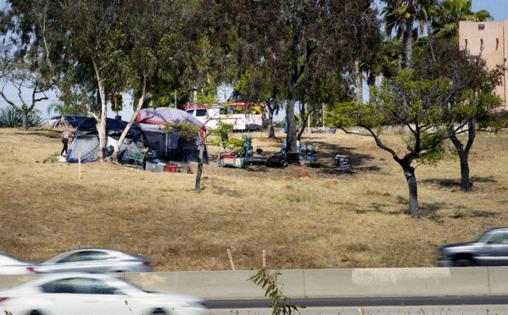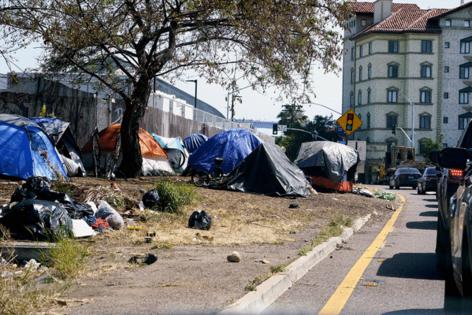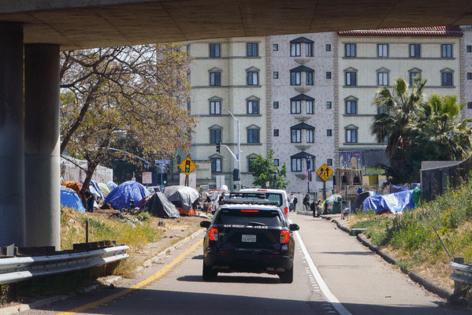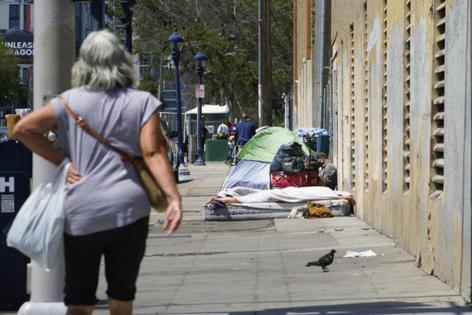Homelessness is up throughout San Diego County, but not by as much as you might think
Published in News & Features
SAN DIEGO — The number of people living outside or in vehicles rose in Escondido, Encinitas and El Cajon.
That population also increased in Vista and Chula Vista and the city of San Diego.
Yet, while more than 10,000 homeless people were again tallied countywide in January, the highest total in more than a decade at least, the overall rise was less pronounced than in recent years.
"What we're starting to see is maybe a high-water mark," Tamera Kohler, CEO of the Regional Task Force on Homelessness, said in an interview. "Now, maybe we can right size our system."
The task force's annual point-in-time count, the results of which were released Wednesday, found at least 10,605 individuals countywide without a steady roof near the start of the year.
That was a slight increase from 2023, although the share without a bed rose significantly: More than 6,100 people were tallied as unsheltered, an 18 percent rise year-over-year.
That may be partially due to some new homelessness initiatives not qualifying as "shelter," such as safe parking lots where people can sleep in cars. The same goes for San Diego's two designated camping areas near Balboa Park, known as safe sleeping sites, which recently held more than 470 people.
Both approaches can come with security and support services, but lack roofs, walls and traditional beds.
The number of homeless people who did have a bed decreased by almost 600. Fewer than 4,500 were counted in places like the East County Transitional Living Center, Father Joe's Villages or private hotels.
It's not that shelters now have open spots. Instead, Kohler attributed that drop to the end of some pandemic-era aid, mainly from the federal government, which had paid for hotel rooms.
Couples and adults with children are often good candidates for hotels, and perhaps unsurprisingly there's been a rise in unsheltered families, from two dozen last year to 43 in January.
The vast majority of those without a roof — 81 percent — again reported becoming homeless in San Diego County.
This was the first point-in-time count since the San Diego City Council passed a camping ban, which boosted penalties for sleeping outside. That ordinance corresponded with a notable drop in encampments downtown and it has been unclear where many of those people went.
The tally does show more unsheltered individuals in nearby cities.
In North County, Escondido's population jumped to more than 400, increasing by about a third, while Carlsbad and Vista each almost doubled to 112 and 170, respectively.
In the south, Chula Vista went from fewer than 320 people to more than 500. Spring Valley's population in East County increased by dozens to nearly 130.
But each area's overall portion of the homeless population, which includes those in shelters and on the street, generally didn't see a dramatic shift. The city of San Diego still has about two-thirds of the total. North and South counties saw their shares grow only around 2 percent.
East County actually recorded a drop, from 17 percent of the county's total to less than 12, which may be due to fewer people renting hotel rooms. (More hotels in El Cajon had agreed to accept vouchers than businesses elsewhere, which also led to local leaders increasing oversight of those programs.)
Kohler attributed the larger numbers in individual cities to a lack of affordable units. One recent countywide study found that large shares of low-income residents were spending more than half their incomes on rent, which can precede homelessness.
"We have an increased population that is struggling to find housing," Kohler said. "That is now in places that were historically considered more affordable."
If anything, the camping ban seemed to cause some people to trade downtown San Diego for other neighborhoods in the same city, according to Kohler.
Similar ordinances have been considered in other communities. Poway adopted one. National City decided against it. Escondido hasn't yet banned camping but adopted a new homelessness policy emphasizing the importance of sobriety.
At the same time, everyone is waiting to see whether the U.S. Supreme Court gives cities more leeway to clear encampments. A ruling is expected in the coming weeks.
Only seven locations countywide saw fewer unsheltered residents. Most were either small unincorporated communities like Alpine or the numbers involved were negligible. Coronado, for example, found nobody living outside in January. Last year, there was one.
The data gives further clues about how individual groups are doing.
More veterans continue to end up on the street — there were more than 540 this year — although they still account for less than a tenth of the total. The share of older adults who are unsheltered remains around 30 percent.
Racial disparities persist. Black people make up about 5 percent of everyone in the county but account for nearly a fifth of the homeless population.
The oldest person found was an 85-year-old Hispanic woman. More than 80 kids had no shelter.
The point-in-time count is required by the U.S. Department of Housing and Urban Development and offers a rare look at the entire region. Yet there are weaknesses.
The tally covers only one day and relies heavily on volunteers. Anyone couch surfing or using their own money to stay in a motel is likely to remain hidden. In addition, how many people can be found has always been influenced by the weather, and this year's count happened just days after the historic Jan. 22 storm displaced people around the region.
The task force also releases monthly reports that track anyone asking for help, and those statistics are arguably more reliable.
In April, the nonprofit reported that more than 1,300 people had lost a place to stay for the first time while fewer than 970 homeless individuals found housing, marking the 25th straight month the crisis grew.
________
©2024 The San Diego Union-Tribune. Visit sandiegouniontribune.com. Distributed by Tribune Content Agency, LLC.














Comments